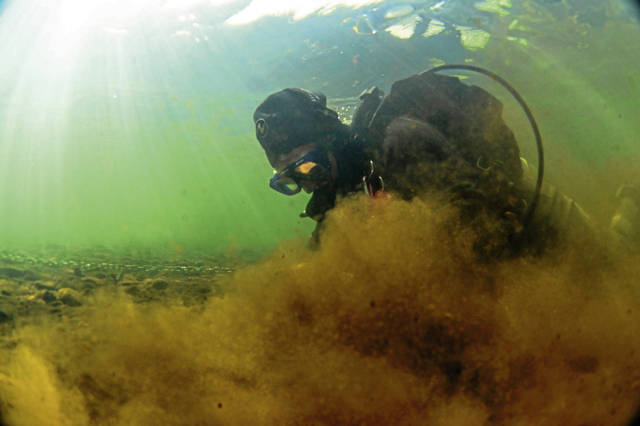https://development.triblive.com/local/valley-news-dispatch/after-missing-for-more-than-100-years-8-species-of-freshwater-mussels-found-in-the-kiski/
After missing for more than 100 years, 8 species of freshwater mussels found in the Kiski

—
A recent scuba survey of the Kiski River, the first in more than 110 years in what was once a dead river, turned up eight species of freshwater mussels, surprising researchers.
For more than a century, the river was sullied by large amounts of noxious drainage from coal mining and other industrial pollution. The curator of invertebrate zoology at the Carnegie Museum, A. E. Ortmann, in 1909 declared freshwater life in the Kiski River was extinct.
Now, plying the dark emerald waters of the Kiski River on a clear day, you can see the bottom studded with rocks and, if you look closely, freshwater mussels.
That is the case if you are on the dive team of the Western Pennsylvania Conservancy. In September, the team conducted a series of surveys on the Kiski. The Tribune-Review accompanied the researchers, documenting their underwater discoveries in clear waters captured for the first time with high quality optics.
The divers use their bare hands to feel the river bed and pluck out a live mussel, or they may spot one after developing an eye for them.
“We call it ‘mussel vision,’ ” said Alysha Trexler, project manager and a watershed scientist with the Western Pennsylvania Conservancy.
Trexler apparently has the gift, as she easily found a mussel known as a “spike” while walking around in the Kiski before she dove into deeper water.
The river work is rough, literally, as researchers crawl along the river bed. They scrape the bottom so much that to preserve his wetsuit, Eric Chapman, lead diver and director of aquatic science for the Western Pennsylvania Conservancy, wears a pair of roomy, thrift store Cabella jeans, blown out at the knees, over his dive suit.
To survey, they throw a chain across the river to use as a grid so they can sample sections of the river scientifically. The divers submerge with empty mesh bags and a special underwater slate and pen.
During their September surveys, they found freshwater mussels that haven’t been observed for more than a century, including common species with names such as spike, plain pocketbook, pocketbook, fat mucket, fragile papershell, pink heelsplitter, black sandshell and mapleleaf.
“The finding of this many species of mussels in the Kiski, at various ages, is testament to the resiliency of freshwater systems, and, given time, (they) can recover,” Chapman said.
Some of the mussels found in the Kiski dives were very young, and some were at least 10 years old, maybe more than 20 years old, indicating the recovery of these pollution-intolerant mussels was underway well before anyone knew about it.
Mussels are indicators of long-term improvement, more so than the presence of fish. If there is bad water, fish can swim away.
Mussels can’t.
“This is good news for the Kiski,” said Rick Spear, aquatic biologist supervisor for the Pennsylvania Department for Environmental Protection’s southwest regional office.
There were clues to the rebounding river other than increasingly robust fish populations, which have been reported extensively over the past two decades.
Reports of a hellbender salamander caught by an angler on the Kiski in 2018 and one freshwater mussel found during a litter cleanup in 2017 caught the interest of the conservancy. The nonprofit secured funding from the Colcom Foundation to take a deeper dive into the Kiski and other impaired waterways to finds signs of life.
Acid drainage from abandoned coal mines remains the major source of impairment for rivers, Spear said. The Department of Environmental Protection and other agencies and organizations continue to share their data to try to accelerate recovery of the rivers, he said.
This and other recent mussel reports in other previously polluted waterways in the region — no others were declared dead as the Kiski was — could mean mussels live in a number of waterways where people weren’t looking for them.
“That is why our agency and our partners keep looking for mussels,” said Nevin Welte, a malacologist/nongame biologist with the Pennsylvania Fish and Boat Commission.
PFBC staff look for mussels as part of the agency’s unassessed waters program.
“With water quality improvements since the Clean Water Act making it safe (or safer) to survey some of these areas, we’re still making new discoveries about how well, or not, some streams have recovered,” Welte said.
“The Kiski is blessed with having the amazing Allegheny River to flow into,” he continued. “Allegheny River pool 4, at the confluence of these two rivers, harbors state and federal endangered species, state endangered species and rare species in a somewhat intact riverine environment that would be reminiscent of the environment during the era before locks and dams,” Welte said.
The Western Pennsylvania Conservancy will continue its surveys next year in the Kiski and elsewhere.
Copyright ©2026— Trib Total Media, LLC (TribLIVE.com)
